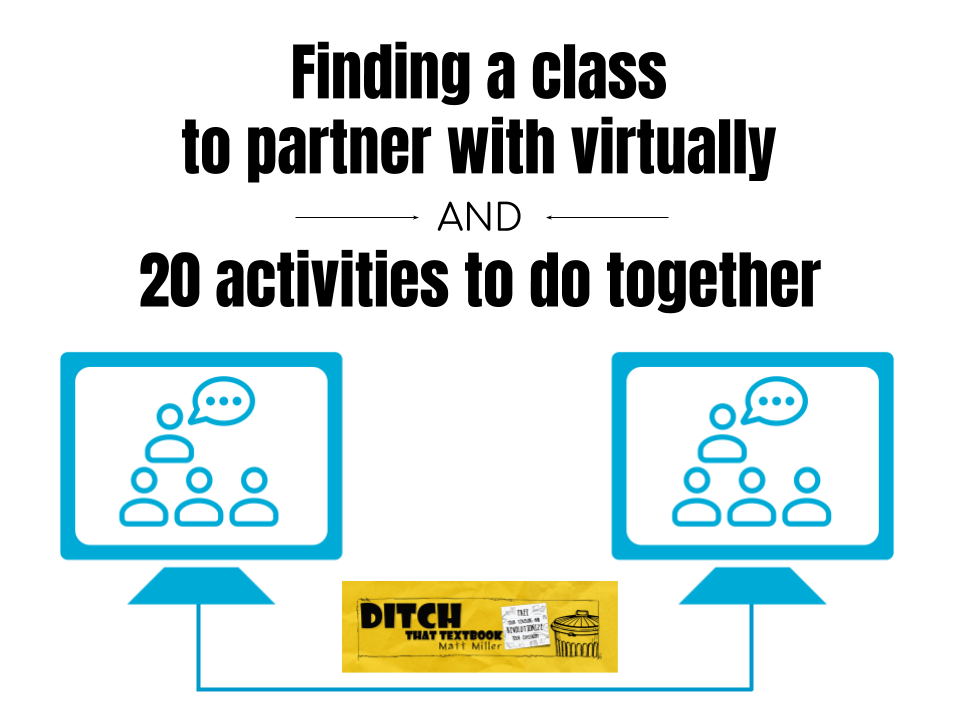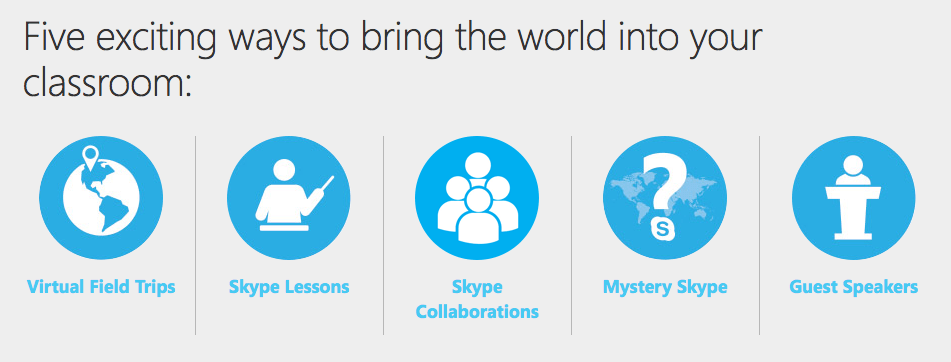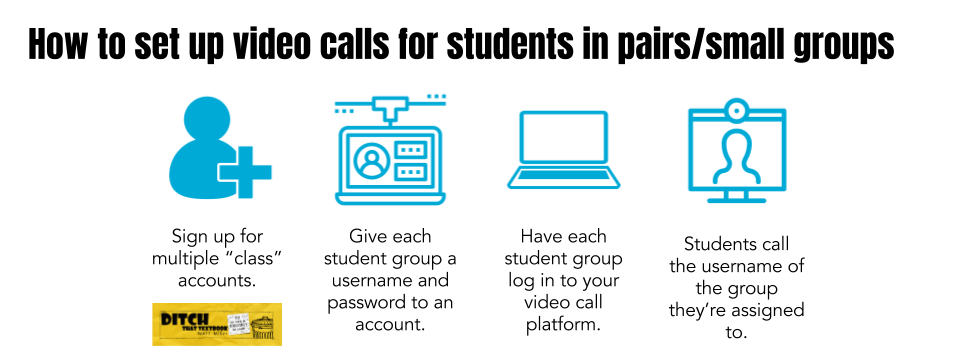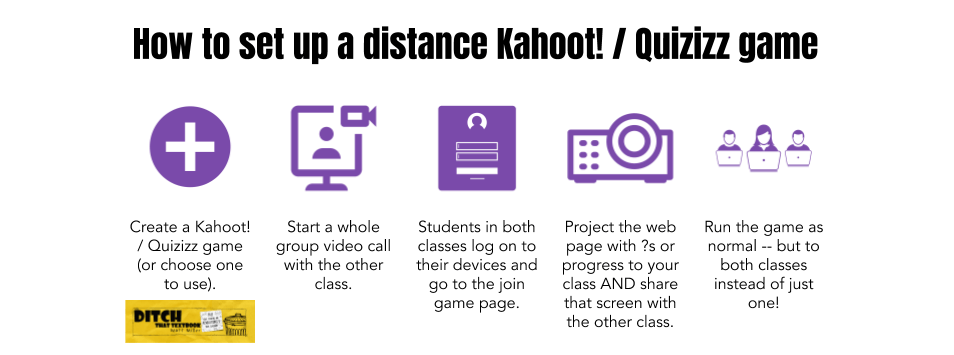
Video calls can get your students connected to others just like them around the country and world! Here's how to do it using Skype, Google Hangouts and others. (Graphic by Matt Miller)
It's a big, big world out there, and it's easier than ever to reach out to someone.
Does your class reflect that?
We have access to content area experts, virtual field trips and classes to partner with virtually. Gone are the days when students are limited to what's contained inside the textbook and the teacher's brain.
So many of us use FaceTime, Skype and Google Hangouts personally to video call friends and family, yet the technology hasn't crossed over into the classroom.
It's pretty accessible, and it might be easier than you think to get your class connected.
In this post, I'll show you ...
- The power of the partner class
- How to find partner classes virtually
- How to make a video call
- Some video call guidance and ideas
- 20 activities to do with virtual partner classes
It's a big, world out there. It's easier than ever to get connected. Does your class reflect that?
The power of the partner class
Communication and collaboration aren't just part of the 4 C's (along with critical thinking and creativity). They're top job skills in the workplace.
Ability to work in a team, problem-solving skills and verbal communication skills rank in the top five attributes employers seek on a candidate's resume for 2017.
Plus, so many students are such social creatures by nature. They're curious, and they want to know about other people.
Partnering with another class virtually through a video call platform like Skype or Google Hangouts can reach students in these ways like a traditional classroom can't.
There are thousands of teachers around the world that are looking to connect their classrooms with other classes, guest speakers and virtual field trips.
Yours could be the next.
How to find partner classes virtually
It's not as hard as you may think.
There's a database of teachers and several online forums that make it pretty easy to get in touch with other teachers.
I'm a Skype Master Teacher, but I go through the same steps that anyone else would. (There aren't any special magical channels for finding people to video call!)
First, the database. Then the forums.
THE DATABASE: SkypeInTheClassroom.com -- This is my go-to first option for finding another classroom to partner with. When you go there, use the "Skype Lessons," "Skype Collaborations," or "Mystery Skype" buttons. You'll find other teachers and the projects and lessons they're working on.

Scan through these databases of Skype contacts on the Skype Education site at SkypeInTheClassroom.com.
It doesn't hurt to reach out to several educators in hopes of eventually reaching one. Some in the database are inactive and might not see your messages.
The upside: If you reach out to several and get replies from a few, you can pick and choose -- or have video calls with multiple guests!
THE FORUMS: Several communities on Google Plus and hashtags on Twitter can get you in touch with teachers you could collaborate with.
If you don't do Google Plus, not to worry ... it's just like Facebook for Google. If you have a Google account, you likely have access to Google Plus and can start using these communities immediately (or after being accepted).

The Connected Classrooms community on Google Plus lets you reach tens of thousands of educators to help you find the perfect virtual guest/classroom.
- Google Plus community: Connected Classrooms
- Google Plus community: Mystery Location Calls
- Google Plus community: Google Hangouts in Education
- Google Plus community: Mystery Hangout
- Google Plus community: Educators on Google Plus
- Twitter hashtag: #mysteryskype
- Twitter hashtag: #skype2learn
- Twitter hashtag: Find a hashtag that fits your role in education from this list
How do I make the video call?
It's as easy as creating an account.
- Skype can be run from Skype software that you download OR on done on the web. (Note: As of publication of this post, it's not possible to do a video/voice Skype call on a Chromebook.)
- Once you have a Google account, Hangouts can be accessed at hangouts.google.com. (If your school has disabled Hangouts, sometimes logging in with a personal Gmail account can work -- if you're OK with doing that.)
You can run whole group video calls from your teacher computer/laptop with a projector -- or even with an iPad mirrored to a projector.
Doing one-on-one OR pair-to-pair OR small group-to-small group video calls takes a bit more work.
(Note: Terms of service for Skype and Google Hangouts say U.S. users should be 13 to use these services on their own. Younger users could use it under the supervision of an adult as long as your school is OK with that interpretation of the terms of service.)
Here's how I've set it up:
- I signed up for and created multiple class Skype accounts for my students to use. (We did this in groups of two.)
- Student groups were given a username/password to one of the accounts.
- They powered up their devices and logged into Skype with that username/password.
- They called the username of the students they were paired up with in the partner class.

Want to have individual students, pairs or small groups make video calls? Here's one way I've managed it. (Infographic by Matt Miller)
Some more video call ideas and guidance ...
In episode 38 of the Google Teacher Tribe podcast, co-host Kasey Bell and I discuss many ways Google Hangouts can be used in the classroom. We also share some tips and tricks for making it successful.
You can see the full show notes here, or use the player below to listen!
20 activities to do with virtual partner classes
So ... we found a partner class to video call.
What do we do now?
There's so much! And honestly, there are not really any rules. It's just you and the teacher of the partner class. (And the students, of course!)
You call the shots. You decide what experiences your students would love or what would benefit them most.
It's nice to have some example ideas to borrow -- or to inspire your own ideas. Here are some places to get started ...
So, we found a partner class to video call. What do we do now? Here are 20 activities to try!
1. Mystery Skype -- This is the classic icebreaker activity. It's loved by virtually all age groups. I've had plenty of high school kids get giddy about a Mystery Skype call. It's a global guessing game where you ask yes/no questions to another class in hopes of eventually guessing in which state/country they live. There are TONS of resources about doing Mystery Skype calls. (Of course, these can be done with Google Hangouts or FaceTime or any other video call platform).
2. Collaborative writing/creating -- Instead of giving students an assignment to write or create something with new knowledge, assign it to that student AND another student from your partner class. They could chat about their ideas and plans on a one-on-one video call (see above). Once that's done, they can collaborate directly inside a shared Google Doc or online Word document.
3. Shared slide presentation -- This activity gives every student a space to write, create or think visually. When students are done with their individual work, they can see each other's slides and add comments. This creates digital discussions about what they're studying.
How to set it up: Create a slide presentation (Google Slides, PowerPoint Online, etc.) with enough slides for every student in both classes. (In fact, create a few just to be safe.) Use the "Share" button and share that presentation with every student, giving them edit rights ("Anyone with the link can edit" or "Anyone in <<your district/organization>> can edit"). Students then jump into the slide presentation and find a blank slide to claim. (I suggest that they type their name in the title part of the slide.)
4. Distance Kahoot!/Quizizz game -- Kahoot! and Quizizz are lots of fun, but you can take it to the next level by doing one with your partner class! This way, students can play not only against their classmates in person but also with their classmates from afar.

Run a Kahoot! or Quizizz game with both your class and your virtual partner class! Here's how. (Infographic by Matt Miller)
How to set it up: Create a Kahoot! / Quizizz game or find one you want to use. Start a whole group video call with the other class. Have students log on to their devices in both classes and go to the Kahoot! / Quizizz "join game" page. Display the webpage you'd show students on your projector AND do a screen share on that screen on the video call. Run the game as you normally would -- but with both classes!
(Note: Network and Internet bandwidth issues may cause problems with this. The class receiving a Kahoot! game via video call will be at a disadvantage because of the slight delay the video call creates. Just know all of this before trying it ... but still give it a try!)
5. Presenting to the group -- If you have students do oral presentations to the class at the end of a lesson or unit, bring your partner class in, too! They can ask questions, share reflections and give feedback as well.
6. "Stump me" game -- How well do your students know their stuff? Have both your class and the partner class create quiz questions to ask each other. Make it a game, or play just for fun!
7. Paired or individual discussions -- Use the one-on-one call instructions above to let students talk individually, in pairs, or in small groups. They can be formal questions with pre-determined discussion questions, free discussions about whatever students are curious about, or somewhere in between.
8. Curating resources with Padlet -- Padlet is like a digital bulletin board. One person (or a whole class ... or TWO whole classes) can add virtual sticky notes with text, images, links and more. Create a Padlet wall and share it with both classes so that they can all edit. Have students share links to resources or ideas about content they're studying in one place.
9. Awesome Squiggles -- This is a global art challenge for PreK-12 students. They get four squiggly lines and are challenged to create art based on those lines. Students enter from all over the world. For more information, go to awesomesquiggles.weebly.com.
10. Global Read-Aloud -- In this program, books are chosen for different grade levels and assigned to participating classes. Those classes get connected with other classes from around the world to read together and discuss what they've read. For more information, go to theglobalreadaloud.com.
11. Literacy Month -- Literacy Month combines World Read Aloud Day (different from the Global Read Aloud above) and World Book Day. Skype makes hundreds of guest speakers available, including authors, illustrators, and other literacy partners. For more information, go to education.microsoft.com/literacy.
12. Virtual Valentines -- The Virtual Valentines Project is an easy, free project designed to teach students geographical awareness and cultural understanding while connecting classrooms all around the world for Valentine's Day. For more information, go to virtualvalentines.weebly.com.
13. Any lesson found on Skype Education site -- Skype lessons are live learning activities given by experts via Skype around a specific topic or theme. Choose one and participate in it together with your partner class! For more information, click on this link.
14. Sharing culture (songs, food, customs, etc.) -- If your partner class is far geographically from your students, chances are there are some differences between life there and life in your community. Whether in the same country or not, share and compare the important parts of life.
15. Perspectives on history and current events -- History and the news can be portrayed very differently in different locations. Talk about past or current issues with your partner class, on how they've been presented, and on their feelings about them based on their unique life experiences.
16. Respond to a Flipgrid -- Once you're connected to a partner class, not everything has to happen on a video call. Use Flipgrid (flipgrid.com) to pose a prompt or question to both classes and let students record short video responses to it. Once they've recorded, they can listen to each other's short Flipgrid videos. Give closure to the activity with a whole-class debrief of the activity.
17. Draw responses on Formative -- The ways we represent ideas visually may be different based on our location. Having students draw representations of what they've studied on a "show your work" drawing question in Formative (goformative.com) has many benefits. It makes a concrete visual connection to new content. Plus, it can show how new ideas can be perceived differently based on location.
18. Have one teacher teach both classes -- Between you and your partner teacher, is one of you more of an expert at a certain topic? Does one have experiences to share that the other doesn't? Take advantage of that great opportunity and let that teacher teach both classes! This also frees up the other teacher to circulate around the room and answer questions -- or to field questions from students in the other class via Google Classroom, a TodaysMeet backchannel or more.
19. Take on a service project together -- Is there a cause that's near and dear to your hearts -- or your curriculum? Help students take action in your class and your partner class with a join service project. Raise money. Volunteer. Make something to send to a worthy recipient. And tie all of the activities that lead up to it to academic standards.
20. Celebrate! -- After a year (or a semester or unit) of hard work and collaboration, celebrate together to further build the bond between your students and those in your partner class.
Question: How do you use video calls in your classroom? What activities have you tried that have been successful? Please leave your thoughts in a comment below!
For notifications of new Ditch That Textbook content and helpful links:
- like Ditch That Textbook on Facebook
- follow @jmattmiller on Twitter
- check out the #DitchBook community on Twitter
- follow Ditch That Textbook on Pinterest
- check out the Ditch That Textbook YouTube channel!
Interested in having Matt present at your event or school? Contact him by e-mail!
Matt is scheduled to present at the following upcoming events: [getnoticed-event-table scope="upcoming" max="15" expanding="false"]





